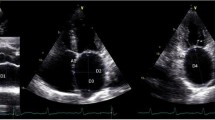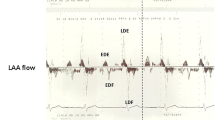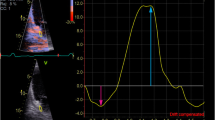Abstract
Purpose
This study examined the role of left atrial (LA) appendage wall velocity (LAAWV) measurement in addition to LA size for the noninvasive assessment of thrombogenesis in patients with atrial fibrillation (AF) and normal plasma D-dimer levels.
Methods
In 58 non-valvular AF patients, LAAWV and the LA volume index (LAVI) were determined by transthoracic echocardiography. LA appendage flow velocity and severity of spontaneous echo contrast (SEC) were determined by transesophageal echocardiography.
Results
LAAWV was strongly correlated with LA appendage flow velocity (r = 0.82), and LAVI was weakly correlated with LA appendage flow velocity (r = −0.37). As SEC severity increased, LAAWV decreased (p < 0.001) and LAVI increased (p < 0.001). Among 52 patients with normal D-dimer levels, LAAWV < 10 cm/s had 71 % sensitivity and 94 % specificity for diagnosing severe SEC. Severe SEC was not found in 18/32 large LAVI patients (>34 mL/m2), but 17 of the 18 patients (94 %) had LAAWV < 10 cm/s. Severe SEC was found in 3/20 patients with normal LAVI, but all of them showed LAAWV < 10 cm/s.
Conclusion
The noninvasive measurement of transthoracic LAAWV in addition to LA volume is clinically relevant for quantitatively assessing thrombogenesis in AF patients with normal D-dimer levels.



Similar content being viewed by others
References
Gage BF, Waterman AD, Shannon W, et al. Validation of clinical classification schemes for predicting stroke: results from the national registry of atrial fibrillation. JAMA. 2001;285:2864–70.
Komatsu T, Tachibana H, Satoh Y, et al. Relationship between CHA(2)DS(2)-VASc scores and ischemic stroke/cardiovascular events in Japanese patients with paroxysmal atrial fibrillation without receiving anticoagulant therapy. J Cardiol. 2012;59:321–8.
Chao TF, Lin YJ, Tsao HM, et al. CHADS(2) and CHA(2)DS(2)-VASc scores in the prediction of clinical outcomes in patients with atrial fibrillation after catheter ablation. J Am Coll Cardiol. 2011;29:2380–5.
Inoue H, Nozawa T, Okumura K, et al. Prothrombotic activity is increased in patients with nonvalvular atrial fibrillation and risk factors for embolism. Chest. 2004;126:687–92.
Mahé I, Drouet L, Simoneau G, et al. D-dimer can predict survival in patients with chronic atrial fibrillation. Blood Coagul Fibrinolysis. 2004;15:413–7.
Nozawa T, Inoue H, Hirai T, et al. D-dimer level influences thromboembolic events in patients with atrial fibrillation. Int J Cardiol. 2006;109:59–65.
Caplan LR, D’Cruz I, Hier DB, et al. Atrial size, atrial fibrillation, and stroke. Ann Neurol. 1986;19:158–61.
Gustafsson C, Britton M, Brolund F, et al. Echocardiographic findings and the increased risk of stroke in nonvalvular atrial fibrillation. Cardiology. 1992;81:189–95.
Faustino A, Providência R, Barra S, et al. Which method of left atrium size quantification is the most accurate to recognize thromboembolic risk in patients with non-valvular atrial fibrillation? Cardiovasc Ultrasound. 2014;12:28.
Ayirala S, Kumar S, O’Sullivan DM, et al. Echocardiographic predictors of left atrial appendage thrombus formation. J Am Soc Echocardiogr. 2011;24:499–505.
Hoshi Y, Nozawa Y, Ogasawara M, et al. Atrial electromechanical interval may predict cardioembolic stroke in apparently low risk elderly patients with paroxysmal atrial fibrillation. Echocardiography. 2014;31:140–8.
Sadanaga T, Sadanaga M, Ogawa S. Evidence that D-dimer levels predict subsequent thromboembolic and cardiovascular events in patients with atrial fibrillation during oral anticoagulant therapy. J Am Coll Cardiol. 2010;55:2225–31.
Krarup LH, Sandset EC, Sandset PM, et al. D-dimer levels and stroke progression in patients with acute ischemic stroke and atrial fibrillation. Acta Neurol Scand. 2011;124:40–4.
Sugiura S, Fujii E, Senga M, et al. Clinical features of patients with left atrial thrombus undergoing anticoagulant therapy. J Interv Card Electrophysiol. 2012;34:59–63.
Habara S, Dote K, Kato M, et al. Prediction of left atrial appendage thrombi in valvular atrial fibrillation. Eur Heart J. 2007;28:2217–22.
Cianfrocca C, Loricchio ML, Pelliccia F, et al. C-reactive protein and left atrial appendage velocity are independent determinants of the risk of thrombogenesis in patients with atrial fibrillation. Int J Cardiol. 2010;142:22–8.
Cohen A, Ederhy S, Meuleman C, et al. D-dimers in atrial fibrillation: a further step in risk stratification of thrombo-embolism? Eur Heart J. 2007;28:2179–80.
Pollick C, Taylor D. Assessment of left atrial appendage function by transesophageal echocardiography: implications for the development of thrombus. Circulation. 1991;84:223–31.
Kamalesh M, Copeland TB, Sawada S. Severely reduced left atrial appendage function: a cause of embolic stroke in patients in sinus rhythm. J Am Soc Echocardiogr. 1998;11:902–4.
Fatkin D, Kelly RP, Feneley MP. Relations between left atrial appendage blood flow velocity, spontaneous echocardiographic contrast and thromboembolic risk in vivo. J Am Coll Cardiol. 1994;23:961–9.
Tamura H, Watanabe T, Hirono O, et al. Low wall velocity of left atrial appendage measured by trans-thoracic echocardiography predicts thrombus formation caused by atrial appendage dysfunction. J Am Soc Echocardiogr. 2010;23:545–52.
Uretsky S, Shah A, Bangalore S, et al. Assessment of left atrial appendage function with transthoracic tissue Doppler echocardiography. Eur J Echocardiogr. 2009;10:363–71.
Sallach JA, Puwanant S, Drinko JK, et al. Comprehensive left atrial appendage optimization of thrombus using surface echocardiography: The CLOTS Multicenter Pilot Trial. J Am Soc Echocardiogr. 2009;22:1165–72.
Yoshida N, Okamoto M, Hirao H, et al. Role of transthoracic left atrial appendage wall motion velocity in patients with persistent atrial fibrillation and a low CHADS2 score. J Cardiol. 2012;60:310–5.
Okamoto M, Fujii Y, Makita Y, et al. Left atrial appendage function in patients with systemic embolism in spite of in sinus rhythm. J Am Soc Echocardiogr. 2006;19:211–4.
Yoshida N, Okamoto M, Nanba K, et al. Transthoracic tissue Doppler assessment of left atrial appendage contraction and relaxation: their changes with aging. Echocardiography. 2010;27:839–46.
Yoshida N, Okamoto M, Hirao H, et al. High plasma human atrial natriuretic peptide and reduced transthoracic left atrial appendage wall motion velocity are noninvasive surrogate markers for assessing thrombogenesis in patients with paroxysmal atrial fibrillation. Echocardiography. 2014;31:965–71.
Gottdiener JS, Bednarz J, Devereux R, et al. American Society of Echocardiography recommendations for use of echocardiography in clinical trials. J Am Soc Echocardiogr. 2004;17:1086–119.
Lang RM, Badano LP, Mor-Avi V, et al. Recommendations for cardiac chamber quantification by echocardiography in adults: an update from the American Society of Echocardiography and the European Association of Cardiovascular Imaging. J Am Soc Echocardiogr. 2015;28:1–39.
Zabalgoitia M, Halperin JL, Pearce LA, et al. Transesophageal echocardiographic correlates of clinical risk of thromboembolism in nonvalvular atrial fibrillation. Stroke Prevention in Atrial Fibrillation III Investigators. J Am Coll Cardiol. 1998;31:1622–6.
Bernhardt P, Schmidt H, Hammerstingl C, et al. Patients with atrial fibrillation and dense spontaneous echo contrast at high risk: a prospective and serial follow-up over 12 months with transesophageal echocardiography and cerebral magnetic resonance imaging. J Am Coll Cardiol. 2005;45:1807–12.
Matsumoto M, Sakaguchi M, Okazaki S, et al. Relationship between plasma (D)-dimer level and cerebral infarction volume in patients with nonvalvular atrial fibrillation. Cerebrovasc Dis. 2013;35:64–72.
Nakatani Y, Mizumaki K, Nishida K, et al. Anticoagulation control quality affects the D-dimer levels of atrial fibrillation patients. Circ J. 2012;76:317–21.
Sadanaga T, Kohsaka S, Ogawa S. D-dimer levels in combination with clinical risk factors can effectively predict subsequent thromboembolic events in patients with atrial fibrillation during oral anticoagulant therapy. Cardiology. 2010;117:31–6.
Zorlu A, Akkaya E, Altay H, et al. The relationship between D-dimer level and the development of atrial fibrillation in patients with systolic heart failure. J Thromb Thrombol. 2012;33:343–8.
Acknowledgments
This study received no grants from any funding agency in the public, commercial, or not-for-profit sectors.
Author information
Authors and Affiliations
Corresponding author
Ethics declarations
Conflict of interest
There are no financial or other relations that could lead to a conflict of interest.
About this article
Cite this article
Yoshida, N., Okamoto, M., Hirao, H. et al. Relevance of transthoracic left atrial appendage wall velocity measurement in addition to left atrial volume for noninvasive and quantitative assessment of left atrial thrombogenesis in patients with atrial fibrillation and normal D-dimer levels. J Med Ultrasonics 43, 175–183 (2016). https://doi.org/10.1007/s10396-015-0688-3
Received:
Accepted:
Published:
Issue Date:
DOI: https://doi.org/10.1007/s10396-015-0688-3




